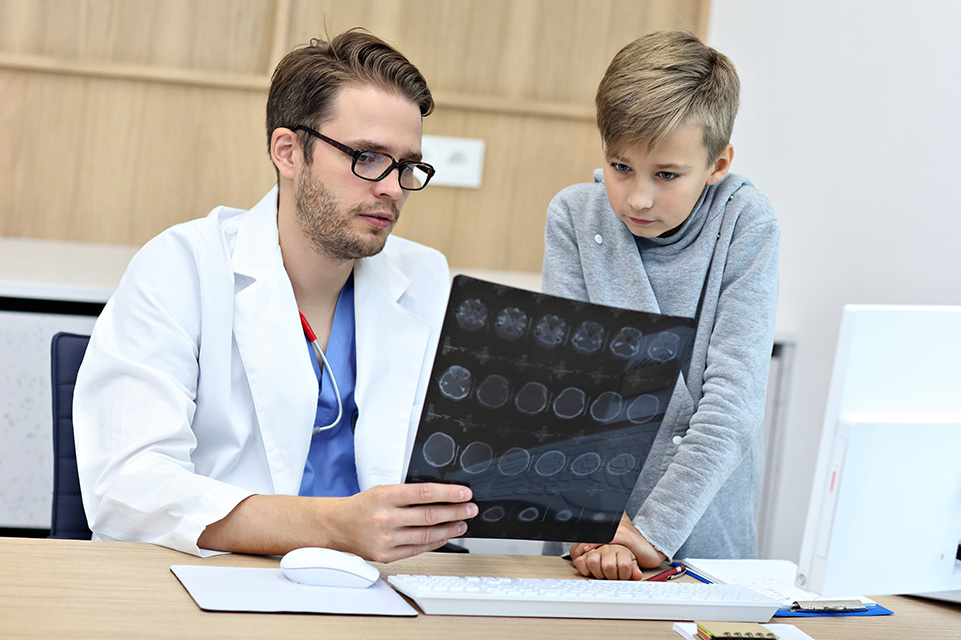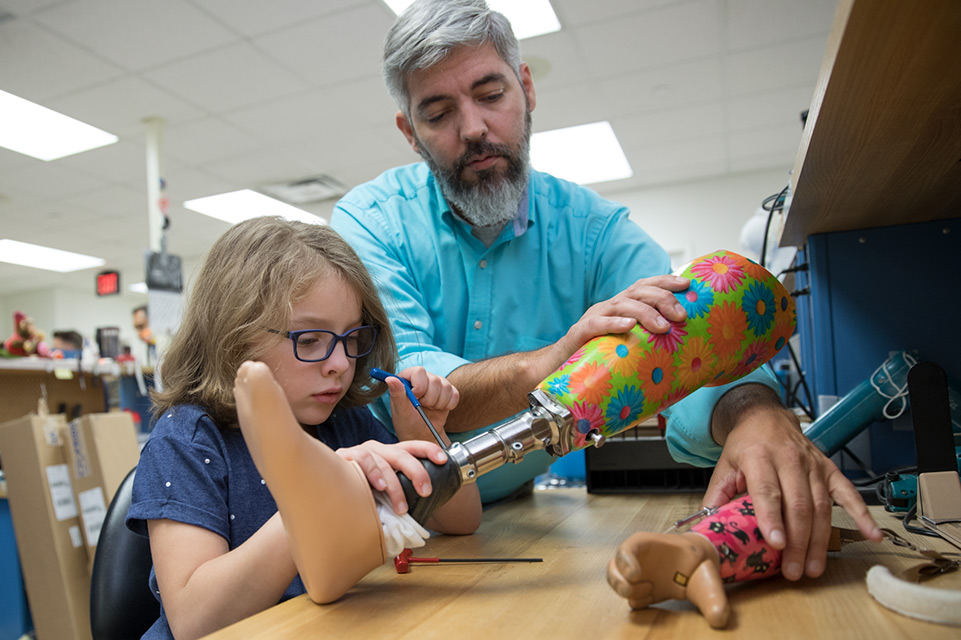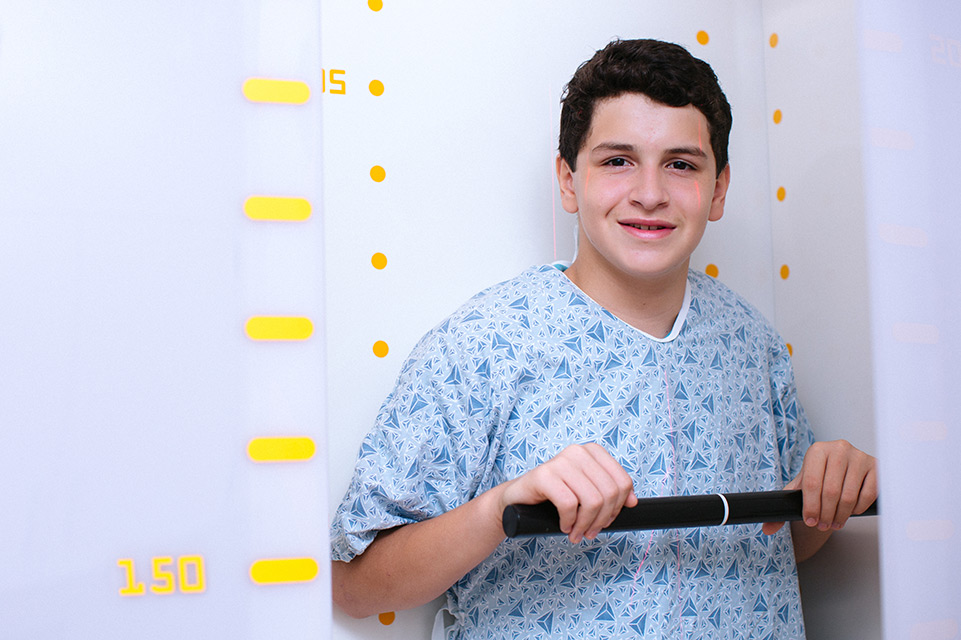Torticollis
A Collaborative Approach to Care for Your Child
Torticollis is a relatively easy-to-spot condition in which your child's head continually tilts to one side. It occurs in about one in every 300 children and affects firstborn children and twins more frequently.
Sometimes called wryneck, this condition may be something your child is born with (congenital) or it may develop in infancy or childhood (acquired).
The most obvious symptom of both types of torticollis is that a child's head tilts one way while the chin tilts the other. Most cases occur when a particular muscle in their neck becomes shortened and contracted, though torticollis itself may be a symptom of a different condition that can range from mild to serious.
Treatment at Shriners Children's
Shriners Children's skilled physicians have diagnosed and treated thousands of children for torticollis. Most cases are uncovered by talking with you about your child's medical history and then conducting a comprehensive physical examination. Your physician will be looking for neck and head stiffness, as well as asymmetry in their face, meaning that one side of their face does not mirror the other.
From there, your Shriners Children's care team will collaborate with you to develop a treatment plan. Most children respond well to physical therapy done in-house by one of our experienced therapists, usually in a few months. Your therapist will work with you and your physician to develop an exercise plan that you can help your child with at home, as well.
Other treatment options may include custom-made corrective helmets designed in our Pediatric Orthotic and Prosthetic Services department to provide a perfect fit for your child, and, in rare cases, surgery by one of our internationally recognized orthopedic specialists to lengthen the short muscle in the neck.
The goal at Shriners Children's is clear: Provide the best possible treatment for your child so they can live the life they want to live.
Specific treatments and services may vary by location. Please contact a specific location for more information.
For as long as I can remember, I have loved Shriners Children's, not just because of the life it has given me, but the real love that comes from it.
Different Types of Torticollis
Congenital muscular torticollis
- Your child has a limited range of motion in the head and neck.
- Their head tilts to one side while the chin tilts to the other.
- A small, pea-sized lump (or “pseudo tumor”) is sometimes found on the sternocleidomastoid (SCM) muscle.
- One side of your child's head may not closely mirror the other.
- They may have other muscle and bone problems, such as hip dysplasia.
Acquired torticollis
- Your child has a limited range of motion in the head and neck.
- Their head tilts to one side while the chin tilts to the other.
- With a condition called benign paroxysmal torticollis, there may be what you see as “attacks,” of head tilting; often these attacks are accompanied by other symptoms, such as vomiting, irritability and drowsiness.
- Additional symptoms vary according to the cause of the torticollis.
What Causes It?
Your baby has a long muscle on each side of their neck that runs from the back of their ear to their collarbone. It is called the sternocleidomastoid, or SCM.
When your baby has torticollis, this ropy muscle is shortened on one side. Your baby might have been cramped in the womb or may have been in an abnormal position, such as a breech position. That can put extra pressure on one side of your infant’s head, which can cause the SCM to tighten.
If your doctor used forceps or a vacuum device during delivery, those also might have put pressure on your baby’s SCM.
In far less common cases, children born with torticollis may have other underlying conditions, including:
- Spine problems
- Short limbs
- Diastrophic dysplasia (dwarfism)
- Several bone growth issues
For children who have acquired torticollis, the causes vary widely and range in severity from mild to extremely serious. Some causes of acquired torticollis include:
- A mild (usually viral) infection
- Minor trauma to the head and neck
- Gastroesophageal reflux (GERD)
- Respiratory and soft-tissue infections of the neck
- Spine problems
- Vision problems (called ocular torticollis)
- A reaction to certain medications (called a dystonic reaction)
- A condition called spasmus nutans, which causes head bobbing along with uncontrolled eye movements
- Sandifer syndrome, a rare condition combining acid reflux with spasms in the neck
Symptoms
Some of the symptoms you might notice:
- Your child’s head tilts to one side with their chin pointed to the opposite shoulder.
- Their head doesn’t turn side to side or up and down easily.
- You feel a soft lump in your baby’s neck muscle. This isn’t dangerous and usually goes away within six months.
- Your baby prefers to look over the shoulder at you. Their eyes don’t follow you because that would require turning their head.
- Your child has trouble breastfeeding on one side or prefers to feed on one side only.
- Your baby works hard to turn toward you, struggles to turn their head all the way and becomes upset because the movement is hard.
- They might start getting a flat head on one side – or both sides – from lying in one position all the time. This is called “positional plagiocephaly.”
Why Treatment Matters
If you act early, you can help prevent any long-term problems for your baby. Without treatment, your baby might develop complications, including:
- Less control of their head
- Limited reach on the affected side and less tracking with the eyes
- Delays in sitting and walking
- A problem feeding
- Poor balance
- Crooked crawling
- Rolling onto one side only
Torticollis Treatment at Shriners Children's
A well-trained, experienced physical therapist will work with your child to encourage your baby to turn their head to stretch that short muscle. They will teach you specific exercises you can do at home on a set schedule, such as during diaper changes.
Your child's physical therapist may recommend using a simple device called a “TOT collar.” TOT stands for Tubular Orthosis for Torticollis, which is really just a small piece of plastic tubing that fits around your baby's neck. The TOT collar is designed to help babies straighten their heads and strengthen their neck muscles. Your physical therapist will teach you the proper way to use a TOT collar.
We're also dedicated to the needs of children who have torticollis with asymmetry of the face and head, known as plagiocephaly. We have found that these children usually respond very well to non-surgical treatments such as:
- Customized, corrective helmets and molding cups
- Sleep position changes
- Special exercises
Sometimes other measures, such as surgery, are required to correct the shortened muscle in torticollis and any asymmetry that may happen with plagiocephaly. Shriners Children's offers a range of treatment options in our orthopedics and plastic surgery programs to help create a bright future for your child.
What You Can Do at Home
Try to get your baby to stretch their neck muscles. It’s the best treatment for torticollis, and it’s safe. Your Shriners Children's physician or physical therapist will teach you some specific exercises to do with your child. These will help lengthen the tighter, short muscle and also strengthen the one on the opposite side.
Here are some other things you can do at home:
- Use your baby’s appetite as an incentive. Offer the bottle or your breast in a way that gets them to turn away from the favored side.
- Place toys so that your baby is forced to look both ways. Those with sounds and lights are really good at drawing their attention.
- Get them to play with their hands and feet. Babies like to bring their hands together and their feet up to their hands. When your baby does this, it builds up muscles they will need to crawl.
- Give them plenty of time on your tummy. Holding your baby this way will strengthen back and neck muscles and keep the back of their head from flattening. You can support them on your chest, across your lap, or on a pillow if that makes it easier.

Convenient, Skilled Physical Therapy
Services We Provide
View All Related Services
Neurology Services

Pediatric Orthotic and Prosthetic Services (POPS)

Radiology and Imaging


